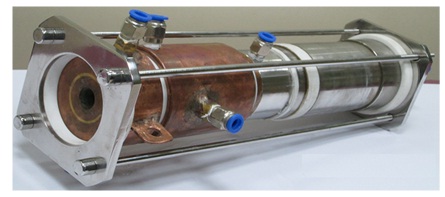The Bhabha Atomic Research Center (BARC) is offering technology for producing air plasma torch. The technology, normally priced at Rs 12 lakh, is offered for Rs 3 lakh, until September 30, 2023.
A thermal plasma jet is a beam of huge concentrated thermal energy at very high temperature consisting of electrons, ions and neutrals. Such plasmas are naturally formed in atmosphere during thunderbolt and observed as a bright flash in the sky. Similar plasma is produced by the offered technology in the form of an intensely luminous extremely hot radiating atmospheric pressure cylindrical plasma jet controlled in terms of its length, diameter, velocity and power content using a small device called air plasma torch. The novel technology offers a compact device that takes air from the atmosphere and converts it into a controlled well-defined jet of air plasma at an electrical power level of many tens of kW with efficiency greater than 60%. Low device cost, low operational cost, simple design, use of cheapest gas (atmospheric air), high efficiency (>60%), high peak temperature (~9000 K at the anode exit) and ease of control are some of the key features of the technology.
Advantages:
- Low device and peripheral cost: reduced installation cost.
- Use of air from atmosphere as plasma gas: low operational cost.
- Light weight portable compact device: easier handling.
- Simple design, easier maintenance: low maintenance cost.
- High efficiency (>60% in non-transferred mode and >95% in transferred mode): better performance
- Extremely low cathode erosion: long electrode life and low operational cost
- Very high plasma temperature (at the exit >8000K): more efficient heat transfer.
- Very long plasma jet (>300 mm): better plasma matter interface.
- Low gas flow requirement (~20 slpm): reduced cost of gas delivery and post treatment section.
POTENTIAL APPLICATION AREAS
- Conversion of waste into energy through plasma gasification
- Municipal and medical waste treatment through plasma gasification
- Hazardous waste destruction
- Nuclear waste immobilization through melting and volume reduction
- Chemical processing industries
- Thermal barrier coatings
- Steel and iron making industries
- Metallurgical alloy making industries
- High temperature testing of heat shield materials
- R& D Applications
Internal components of the device: It has three major sections: (1) plasma source (2) constrictor and (3) main anode. The plasma source section consists of a specially designed hafnium-based cathode, gas distributor and coolant distributor. A single coolant loop caters to all the sectors in this section. With the help of a radio-frequency igniter, the plasma (arc) is initiated in this section between the cathode and the nozzle. Once the source is on, the arc is transferred to the constrictor section at low power. The role of the constrictor is to streamline the plasma jet as well as develop appropriate voltage in the plasma column for operation at a given power level. For a given current and gas flow rate, the power of the plasma jet can be adjusted just by changing length of this constrictor section. The power of the plasma is gradually increased to medium level. Next, the arc is transferred the main anode and full power of the jet is achieved. An extremely bright well-formed huge jet comes out from the device.
Electrical connection with power. Initially both the connectors “A” and “B” are connected and an arc is initiated between the cathode and the nozzle. The connectors are sequentially opened to make a gradual transfer of the arc from the cathode to the constrictor and finally to the main anode. While in operation at full power, both the connectors remain open.
For further details, contact:
Head, Technology Transfer and Collaboration Division
Bhabha Atomic Research Centre,
Trombay, Mumbai 400 085.
technology@barc.gov.in
ALSO READ:
BARC technology for 10 kW, 15 kV Electron Beam Melting (EBM) Machine
Technology for corrosion resistant nickel coating
BARC technology for Copper nano particles from waste printed circuit boards
Low-cost iron aluminide coatings can increase corrosion resistance



